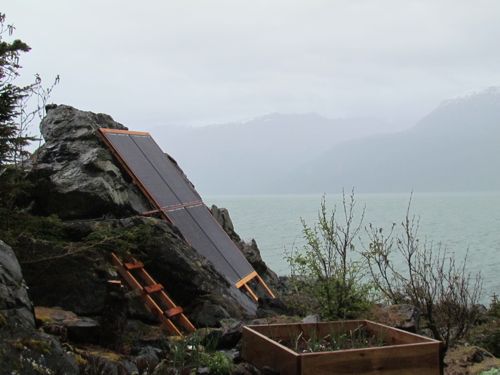We had a week of sunny days beginning the morning after we turned on the new PV array. Talk about a honeymoon!
The array produces an amazing amount of power under full sun, without the spikes and lulls we get from the wind generator. We start registering incoming power when the sun comes over The Mountain With No Name across the fjord, around 6:30 a.m. and continues, from trickle to flood to trickle again until about 8:00 p.m.! This is in early May; June ought to be very good to us.
The charge controller’s regimen of bulk charge, absorb period, and float seems very healthy for our tired old battery bank. It has actually stopped showing the warning signs of wearing out—the very conditions that led to this overhaul of our power system (see Power Shift: A New/Old Battery Bank).
As with any honeymoon, uncertainty and adjustment contribute much to the excitement. It appears that our fusing is inadequate. I have also learned a few things about managing wind and solar together that “all the manuals specify”—except, it appears, the ones we own. I’m eagerly watching the mail for new breakers and other equipment our local hardware stores don’t stock. When they come, I’ll realign our system to make it robust enough to accept all the power these panels have to offer without straining the peripherals.
Finally, like all honeymoons, this one had to come to an end. As I stood admiring the incoming amps on those sunny days, I wondered if we might not get spoiled by those first heady days. The real test of the relationship must wait for the normal day-to-day operations.
Thursday, the clouds returned. As expected, we harvested considerably less solar power. That day we got .8 kilowatt hours (kwH), almost half of the 1.5 kwH we got the previous sunny day. Even so, that’s a substantial amount. Considering that we’ve had very little wind lately, and compared to the solar power we would have gotten on these days with the old array, this seems very satisfactory. It still charged the battery bank to full capacity by midday.
The honeymoon’s over, but the marriage continues (if you’ll allow me to beat this simile to death). The system will change with the addition of the breaker panel, and will change again when the Ni-Fe battery comes. It’s on its way now, finally, but I’m beginning to wonder . . . . The cells will arrive filled but uncharged, and can be stored for a considerable period. We may pack them away somewhere and wring the last power out of the current batteries. In their newly rejuvenated state, they might possibly last a few more years. We can’t predict the future, we can only prepare for possible outcomes, then see what happens.

